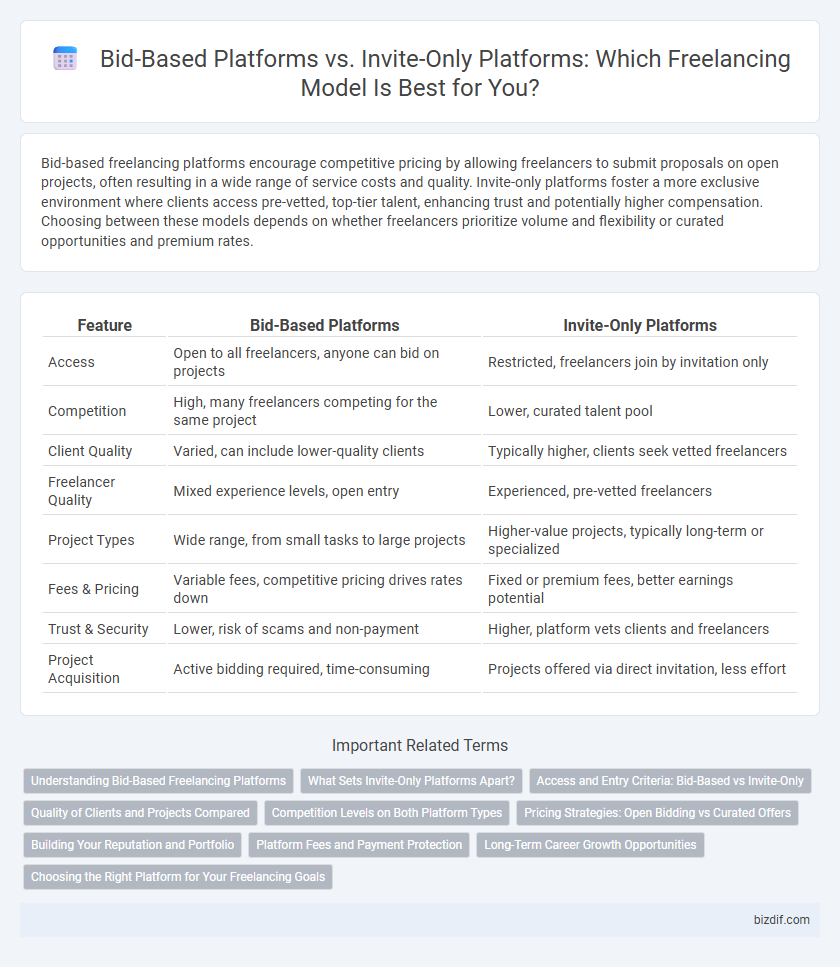Bid-based freelancing platforms encourage competitive pricing by allowing freelancers to submit proposals on open projects, often resulting in a wide range of service costs and quality. Invite-only platforms foster a more exclusive environment where clients access pre-vetted, top-tier talent, enhancing trust and potentially higher compensation. Choosing between these models depends on whether freelancers prioritize volume and flexibility or curated opportunities and premium rates.
Table of Comparison
| Feature | Bid-Based Platforms | Invite-Only Platforms |
|---|---|---|
| Access | Open to all freelancers, anyone can bid on projects | Restricted, freelancers join by invitation only |
| Competition | High, many freelancers competing for the same project | Lower, curated talent pool |
| Client Quality | Varied, can include lower-quality clients | Typically higher, clients seek vetted freelancers |
| Freelancer Quality | Mixed experience levels, open entry | Experienced, pre-vetted freelancers |
| Project Types | Wide range, from small tasks to large projects | Higher-value projects, typically long-term or specialized |
| Fees & Pricing | Variable fees, competitive pricing drives rates down | Fixed or premium fees, better earnings potential |
| Trust & Security | Lower, risk of scams and non-payment | Higher, platform vets clients and freelancers |
| Project Acquisition | Active bidding required, time-consuming | Projects offered via direct invitation, less effort |
Understanding Bid-Based Freelancing Platforms
Bid-based freelancing platforms enable freelancers to compete for projects by submitting proposals and pricing, fostering a dynamic marketplace driven by supply and demand. These platforms often feature transparent bidding processes, allowing clients to compare offers based on cost, experience, and ratings, optimizing project matching efficiency. Understanding the competitive nature and pricing strategies on bid-based sites is essential for freelancers aiming to maximize their chances of securing contracts and building reputation within the ecosystem.
What Sets Invite-Only Platforms Apart?
Invite-only freelancing platforms distinguish themselves by offering exclusive access to pre-vetted professionals, ensuring higher quality and trust in client-freelancer relationships. These platforms often feature rigorous screening processes, which elevate project standards and reduce risks associated with fraud or subpar work. Clients benefit from curated talent pools tailored to specific industries or expertise, fostering more efficient and successful project collaborations.
Access and Entry Criteria: Bid-Based vs Invite-Only
Bid-based freelancing platforms provide open access, allowing freelancers to compete by submitting proposals to a wide array of projects, which lowers entry barriers but increases competition. Invite-only platforms restrict access through selective criteria, often requiring proven expertise or prior client endorsements, enhancing project quality and client trust. These contrasting access models influence freelancers' ability to secure work, with bid-based platforms emphasizing volume and visibility, while invite-only platforms prioritize exclusivity and vetted skills.
Quality of Clients and Projects Compared
Bid-based freelancing platforms typically attract a wide range of clients with varying budgets and project scopes, resulting in a diverse but often inconsistent quality of projects. Invite-only platforms prioritize pre-vetted clients and freelancers, fostering higher-caliber engagements with more specialized, well-funded projects. This selective approach ensures greater reliability and professionalism, enhancing overall client satisfaction and project outcomes.
Competition Levels on Both Platform Types
Bid-based freelancing platforms often experience higher competition levels due to an open marketplace where numerous freelancers actively vie for projects by submitting bids. Invite-only platforms typically have lower competition because clients selectively invite freelancers based on vetted skills and past performance, creating a more exclusive environment. This exclusivity on invite-only platforms reduces bidding wars and fosters higher-quality project matches.
Pricing Strategies: Open Bidding vs Curated Offers
Bid-based freelancing platforms often feature open bidding systems where freelancers compete by proposing lower prices to win projects, fostering competitive pricing but sometimes driving rates down excessively. Invite-only platforms utilize curated offers where clients selectively engage freelancers based on expertise, allowing for premium pricing aligned with specialized skills and higher project value. This model emphasizes quality over quantity, enabling freelancers to maintain consistent earnings without undercutting rates in a saturated market.
Building Your Reputation and Portfolio
Bid-based platforms allow freelancers to build their reputation by actively competing for projects, showcasing a diverse portfolio through numerous completed gigs and client reviews. Invite-only platforms emphasize quality and exclusivity, enabling freelancers to maintain a high-caliber portfolio by accepting selective projects that enhance their professional credibility. Consistent delivery of exceptional work on either platform strengthens reputations, attracting higher-paying clients and specialized opportunities.
Platform Fees and Payment Protection
Bid-based freelancing platforms typically charge higher platform fees, often ranging between 10% to 20%, while offering robust payment protection through escrow services to secure client and freelancer transactions. Invite-only platforms generally have lower or more flexible fees due to selective membership, providing enhanced trust and reduced risk of fraud, but payment protection policies can vary significantly depending on the platform's exclusivity and structure. Choosing between these models impacts cost efficiency and financial security, making platform fee structures and escrow mechanisms critical factors for freelancers seeking reliable income.
Long-Term Career Growth Opportunities
Bid-based freelancing platforms often emphasize short-term projects and competitive pricing, which can limit sustained client relationships and long-term career growth. Invite-only platforms typically provide curated opportunities with higher-quality clients, fostering trust and repeat engagements essential for building a stable freelance career. Consistent collaboration on invite-only platforms supports skill development and reputation enhancement, key drivers for long-term professional success.
Choosing the Right Platform for Your Freelancing Goals
Bid-based platforms like Upwork and Freelancer offer access to a wide range of projects, allowing freelancers to compete by submitting proposals and setting competitive rates, which can be ideal for building diverse portfolios. Invite-only platforms such as Toptal and Gun.io provide curated, high-quality gigs with clients seeking top-tier talent, offering higher earning potential and specialized work but requiring rigorous screening. Selecting the right platform depends on your freelancing goals: bid-based platforms suit those starting out or seeking volume, while invite-only platforms benefit experienced freelancers targeting premium clients.
bid-based platforms vs invite-only platforms Infographic

 bizdif.com
bizdif.com